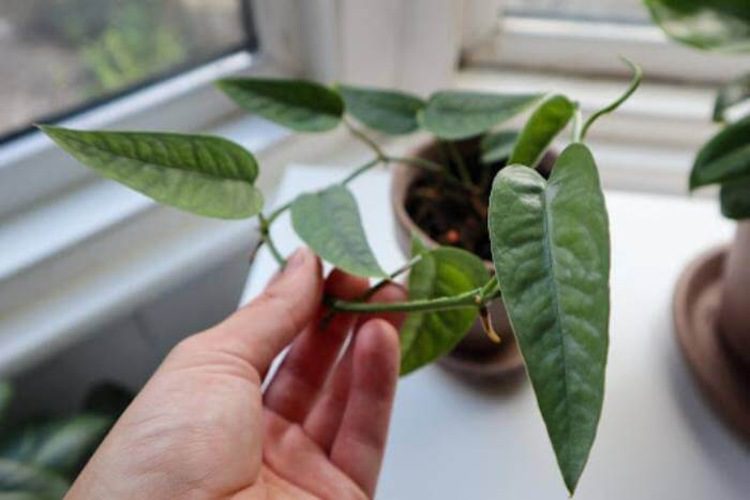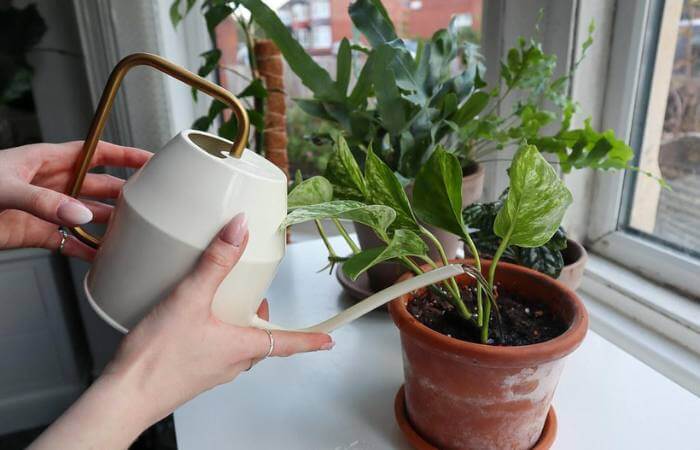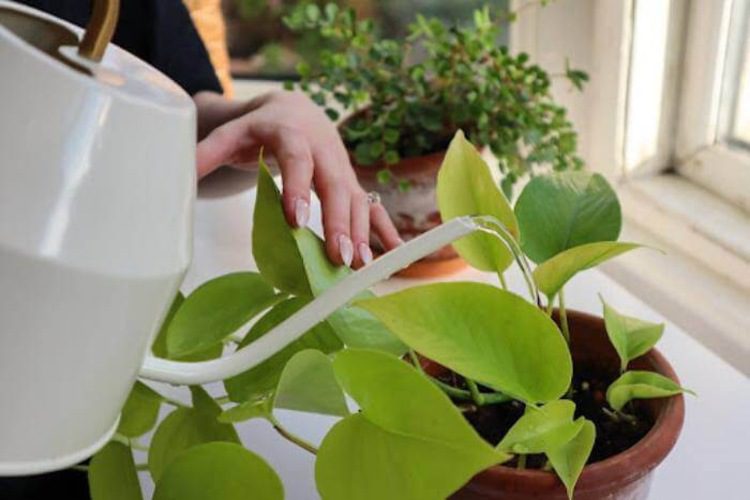Why Is My Pothos So Leggy? 5 Quick Steps To Fix

Fans of pothos love to see their homes and workplaces covered with beautiful, thick leaves. These gorgeous plants will brighten their mornings and freshen the air. But what should you do if your plant gets thinner and just has leafless vines? Many homeowners have the same problem. We have received a lot of questions regarding the issue of why the pothos become so leggy.
This article will help you deal with the case easily. We have covered the signs, causes, and viable solutions for treating leggy pothos. Let’s follow us to find out!
Why Does Pothos Become So Leggy?

Pothos plants are hardy and can keep growing even when you ignore them for a little while. However, they will get thinner if they live in improper conditions for a long time.
Lack of light
Lighting is the most common cause of your leggy pothos plant. Please note that this species requires bright, indirect light to grow. So, when grown in a dark location, your plant will extend its vines to search for better light.
However, due to the lack of light, it doesn’t have sufficient energy to grow both its leaves and stems. As a result, the gap between leaf nodes gets wider while the vines become thinner. Moreover, the leaves are smaller and have a yellow-pale hue.
Too much fertilizer
A Pothos that receives too much fertilizer may also turn leggy. In essence, this enables a sprout to grow more quickly than it should. Long vines may develop on the plant due to the excess nutrients as they look for something to cling to. Consequently, the new leaves will appear stunted, and the gap between the nodes will increase significantly. In some instances, you could even find that the nodes don’t develop any leaves, leaving the vines bare.
Pot size
Moving pothos to a larger container with more space for growth might be a good idea, but doing so will almost always result in a leggy plant. Your pothos plant grows best when its roots are bound. It will even spread out more significantly in the pot if there is too much space for growth. The consequence is that the vines remain, but with no leaves.
Climbing
All varieties of pothos are climbers by nature. In the wild, they grow aerial roots to hold onto tree trunks and climb to the top, reaching more light. A pothos plant will sprout long vines to seek something to hang on to if it has no support to develop. The distance between the leaf nodes also increases as the plant looks for support, resulting in long, naked stems. Some types of pothos are more vulnerable to growing leggy than others. For example, Golden pothos and Satin pothos can grow quickly and may turn leggy more quickly than Jade when kept in unfavorable conditions.
Temperature
Tropical plants like pothos love a hot, humid environment. Hence, a heat wave may give them an extra push and encourage them to shoot out long vines. After checking for other causes and ensuring they are not the case, consider the temperature. Overheating may result in a leggy pothos plant.
What Do Leggy Pothos Plants Look Like?
Leggy is a term used in the plant world to describe a plant with a long stem and only a few leaves. Sometimes, it has “naked” or leafless stems. With pothos, this problem is quite common in hanging baskets. The plants may trail downward in this case.
Long stems
A leggy pothos plant has long, sparsely leafed vines. It spends the majority of its growing time sprouting long stems rather than new roots or leaves. We call this process “etiolation.” Etiolation refers to an unnatural kind of growth. It means that the living environments don’t satisfy the needs of the plants or stay out of balance.
Few leaves
Even when the stems become longer, they have only a few or no leaves. The gap between the leaves is wide. Moreover, the leaves change color from lively green to pale yellow. They don’t grow well; sometimes, you can find bare nodes without any leaf signs on them.
How To Fix Leggy Stems And Foliage On My Pothos?

Fortunately, you can make your leggy pothos bushier and fuller. The best method is to prune it. Also, give it adequate water, light, and nutrients.
Prune pothos
If you never prune your plant, its stems will thin out gradually. The sparse placement of the leaves makes your plant look spindly. Hence, we strongly advise trimming your pothos to stimulate more vines and foliage to develop. Here is how to do it:
Step 1: Mark the vines you intend to cut.
Step 2: Cut each vine about 1/4 inch above the leaf so the new vine can sprout at each node.
Step 3: Trim off the naked vines completely since they won’t regrow.
Pothos species are hardy, so they can endure heavy pruning. Thus, don’t hesitate to prune your plant whenever you want it to grow stronger instead of longer and thinner. The tip for pruning is to cut right below the leaf node. With this method, you won’t leave behind new pothos stems that have yet to develop new growth.
Adjust your watering routine
The problem with leggy growth is that you don’t have lushly-grown foliage. Watering may be one of the best ways to nurture the leaves. Insufficient watering will give you a leggy plant. Moreover, the leaves will turn yellow, wilt, and drop due to the lack of water.
Try to water the plant every one or two weeks. But avoid overwatering, too, as it causes multiple problems, such as stunted growth and root rot. To establish the proper watering routine for your pothos, check the topsoil before each irrigation. If the soil seems dry, give it some water.
Change the lighting condition
Too little light is the primary cause of leggy growth. Your miserable plant will keep extending its vines to seek the light. To help your pothos grow thicker, move them to an area with bright light. You may also install a full-spectrum grow light. Staking is also a good idea to support your trailing plant when it grows in a direction to find the light. You can use a moss pole or a bamboo cane to encourage your plant to grow bigger leaves closer to each other.
Propagate the cuttings
Pruning is an effective method to save your plant, but what if you don’t like throwing pothos cuttings? You can choose to propagate them instead. The instructions for propagating your pothos are as follows:
Step 1: Cut each vine just below the node. The idea is to keep some leaves on the vine.
Step 2: Put the cuttings into water or moss.
Step 3: Once you notice new roots, repot the plant in the same pot as its mother plant or a new one. You can also leave them to grow in water.
The process will take some time. You need to provide your new plants with adequate conditions, just as you do with other indoor plants.
Fertilize regularly
Your pothos will sprout new leaves if you fertilize them properly. This method is very helpful if your plant remains in the same pot that you planted it in. Pothos plants don’t require a lot of food. However, consider correcting dietary deficiencies if they start to look leggy and weak. To promote their growth, use a 20-20-20 fertilizer once or twice every month.
Conclusion
A leggy growth is a nightmare for pothos lovers. Luckily, you can fix this pothos problem by adjusting the plants’ conditions, such as lighting, watering, and fertilization. Consider pruning or propagating to allow for new growth too. Hopefully, you can find the exact answer to your question in this post. Please share if our guide has helped your plant recover. Thank you for reading!
This video will show how to propagate pothos cuttings correctly:
FAQs









